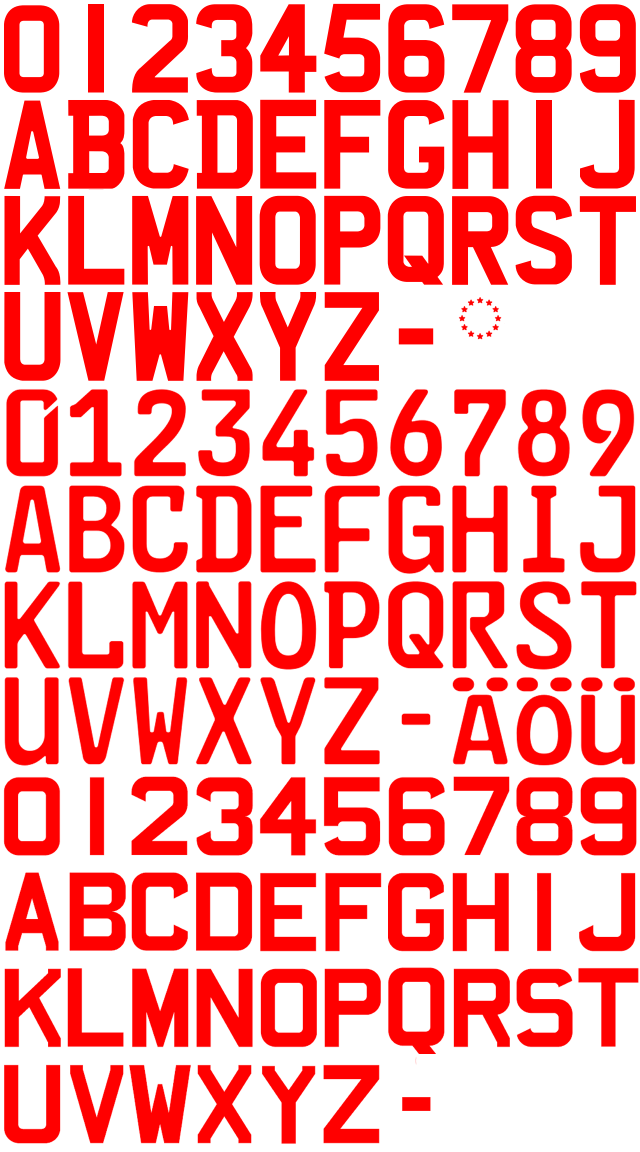A few of my previous hobby projects have used a library of vector graphics approximations of the flags of the world. I decided to re-use that data in a JavaScript web page that draws those flags as SVG images.
In subsequent posts, I'll describe the data encoding for those flags and some of the compression techniques I used.
Sunday, 31 January 2016
Vehicle Number Plates
One of my pet projects for the last few months has been to assemble a web page that decodes (mostly) European number plates, based on the information in Wikipedia.
There's no sane reason to put together such a page, and it's nigh on impossible to keep up-to-date and complete; but at least I've made a start. My long-term goal might have been to allow users to type in any sequence of letters and/or digits and have the web page tell them what that sequence might represent: vehicle number plates, international telephone numbers, credit card numbers, bank accounts, etc. (Ideal for many a protagonist in crime and mystery novels!) But that's a mammoth task: much better as a collaborative, crowd-sourced project.
The current page is a relatively simple client-side JavaScript program that just does regular expression matching and a few table lookups. All told, the compressed payload is about 128 kilobytes, the majority of which is taken up by a glyph grid image:
From top to bottom, the glyph sets are approximately:
You may be wondering why the glyphs are red and not, say, black or white. It all comes down to the way the glyphs are coloured at "runtime". For the supported countries, we need to be able to display number plate glyphs in black, white, silver, dark red and yellow. We do this via CSS 3 filters. Alas, these filters have limited scope for "colourizing" monochrome images (except, perhaps the "sepia" function). So, instead, we start with pure red pixels (hue=0).
To achieve the various glyph colours, we simply manipulate "red" into the desired colour using the limited set of colour-transforming filter functions available to us. So, for black glyphs, we turn down the brightness to zero:
For white, we invert black:
For silver, we turn down the brightness of white:
For dark red, we turn down the brightness of the original red:
And for yellow, we rotate the hue of original red and ramp up the brightness:
None of these transformations have any impact on the alpha channel, so the glyph shape is always unmodified.
There's no sane reason to put together such a page, and it's nigh on impossible to keep up-to-date and complete; but at least I've made a start. My long-term goal might have been to allow users to type in any sequence of letters and/or digits and have the web page tell them what that sequence might represent: vehicle number plates, international telephone numbers, credit card numbers, bank accounts, etc. (Ideal for many a protagonist in crime and mystery novels!) But that's a mammoth task: much better as a collaborative, crowd-sourced project.
The current page is a relatively simple client-side JavaScript program that just does regular expression matching and a few table lookups. All told, the compressed payload is about 128 kilobytes, the majority of which is taken up by a glyph grid image:
From top to bottom, the glyph sets are approximately:
- UK number plates since September 2001
- European numbers plates (FE-Schrift)
- UK number plates before September 2001
You may be wondering why the glyphs are red and not, say, black or white. It all comes down to the way the glyphs are coloured at "runtime". For the supported countries, we need to be able to display number plate glyphs in black, white, silver, dark red and yellow. We do this via CSS 3 filters. Alas, these filters have limited scope for "colourizing" monochrome images (except, perhaps the "sepia" function). So, instead, we start with pure red pixels (hue=0).
To achieve the various glyph colours, we simply manipulate "red" into the desired colour using the limited set of colour-transforming filter functions available to us. So, for black glyphs, we turn down the brightness to zero:
black { filter: brightness(0); }
For white, we invert black:
white { filter: brightness(0) invert(1); }
For silver, we turn down the brightness of white:
silver { filter: brightness(0) invert(1) brightness(70%); }
dark-red { filter: brightness(50%); }
And for yellow, we rotate the hue of original red and ramp up the brightness:
yellow { filter: hue-rotate(60deg) brightness(5); }
Friday, 1 January 2016
New Year, New Home Page
Once again I have succumbed to perceived peer pressure and re-vamped my website's home page. It's now been dragged, kicking and screaming, into the twenty-first century; but fear not Luddites, it's still essentially old school.
Subscribe to:
Posts (Atom)


